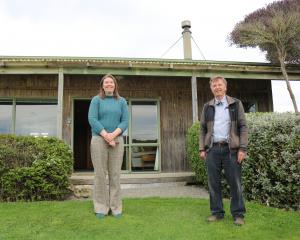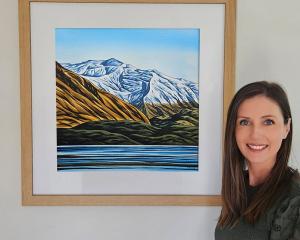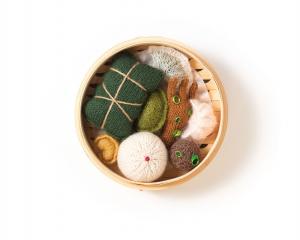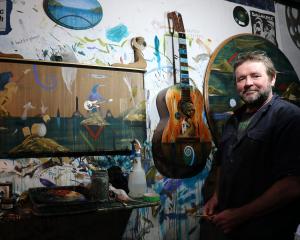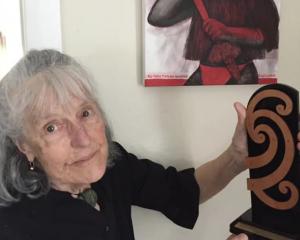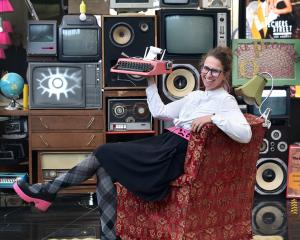
It was just like any normal morning. Fiona Pardington was feeding her dog its homeopathics in her Piha kitchen during the last Christmas-New Year holidays when she felt a bit queasy.
Next thing she knew, she came to on the floor, having blacked out, falling backwards "like a tree" and hitting her head.
She managed to call for help and was soon being rushed to hospital where they "stopped me from dying twice".
"My heart stopped. My blood pressure tanked twice. I had interesting experiences while I was dying."
The incident left her with an acute brain injury. She struggled to talk and to write and, like others with similar injuries, became short tempered and often frustrated.
"I became quite difficult to deal with. It’s going to take a while to heal."
But despite this, she says, and most importantly, Pardington (Ngai Tahu, Kati Mamoe and Ngati Kahungunu and Scottish, Clan Cameron of Erracht, descent) still has the ability to make art.
"I had a lot of cognitive damage but it’s kind of improved. It’s amazing, my art brain just got better not worse. It’s fortuitous and I’m fortunate and grateful basically. I live for art, it’s who I am."
Looking back over the past 11 months, she describes it as a "really unusual year", which included some major projects and commissions coming to fruition.
At the top of the list was the The Golden Huia, commissioned to celebrate the Dowse Art Museum’s 50th anniversary, and her latest exhibition for Starkwhite Gallery, "Tarota", named for the divinatory cards and their ancient archetypal symbols.
It also included moving to the South Island, something she has wanted to do for many years but family kept her in the north. Her injury made her re-think her decision.
"I’m supremely happy to be back. I’m revelling in my return to my roots. I’m closer to everything I need."
Delayed by Covid, she has recently moved into a home in the Hunter Hills, happily surrounded by bird life and with plenty of room for the "mountains" of ephemera she has collected over the years.
While the hand she was dealt could have devastated her, Pardington got on with her recovery by incorporating it into her work.
Unable to look at something, remember it and then reproduce it, she used her work to help her cognitive rehabilitation.

Having trained in oil painting before deciding photography was more her thing back in the early 1980s, Pardington, who was made a Member of the New Zealand Order of Merit in 2017, decided to rediscover those skills and begin painting on objects that she has found rather than just using them as she found them. Along the way she developed a colour palette that was "mine" from paint found under the house and from a French paint shop.
"I was very surprised at how well I did. The process is embedded in that group of photographs in the exhibition."
That positive comment about her work is something Pardington says she would not have said before the accident.
"I’m more thankful and aware of what I was able to do after the accident. Now I’m able to say I think I did a good job. I realise how tenuous life can be."
Although told to stop working so much, Pardington could not.
"I had so much burning desire to see everything through that lens."
Pardington, who was the Frances Hodgkins Fellow in 1996 and 1997 and in 2016 named a Knight (Chevalier) in the Order of Arts and Letters (Chevalier de l’ordre des Arts et des Lettres), has been inspired over the years by British occultist and "outsider artist" Austin Osman Spare (1886-1956) and fellow occultist and magician Aleister Crowley (1875-1947).
"Austin’s a supremely important occult figure now. I’ve been very interested in his drawings."
Her interest developed from memories of staying with her grandmother in Mt Roskill as a child and reading her copies of Man, Myth and Magic, a British weekly magazine that featured his drawings.
"I’d sleep on a camp bed by her bed and she’d feed me boiled eggs and I read them, terrifying myself but being completely entranced."
In "Tarota" she references the tarot deck Spare created, a 79-card, hand-painted set of cards created about 1906. They were only discovered in 2013 in the collection of The Magic Circle Museum in London. She was able to access them through the "tech of biblomancy" via the book Lost Envoy, by Jonathan Allen.
"I was fascinated by the breadth and depth of his (Spare’s) genius as an artist. He did his own thing, he was fearless, profoundly inquisitive and bold."
The base of all the works is "beautiful old, white, Italian marble" Pardington and her partner discovered while pruning some old pohutakawa along her Piha driveway.
"I couldn’t believe my eyes, we levered it out and that is what the art is sitting on, Italian marble that came directly out of the dirt at the side of my driveway. It doesn’t get more extraordinary than that when you are doing a Covid project when you cannot leave the house. That is the underpinning of the show.
"It’s going to be an ongoing substrate to my work."

Pardington is an inveterate collector of things. It is not unusual for her to spend hours at a time fossicking in opshops.
"I’ve been collecting for 20 years or more from all over the place. I’ve got seaweed that I’ve been carrying around for 20 years, I carry water, sea shells, stones — I’ve enormous boxes of stones and rocks, ... I know them all, where they’re from, they’re touchstones."
Having always considered herself a "west coast person" Pardington says she was a bit concerned about living on the east coast when it came to her rock collecting habits.
But she should not have worried. "I’ve found the rock beaches here are outstanding. I’ve been enjoying myself."
So much so she is now on the lookout for a professional rock polishing machine for her work.
"I desperately need one. There are always rocks integrated into my work."
For now, Pardington is concentrating on settling into her new home while she mulls over her next projects. One is likely to feature native birds, another important love of hers, and becoming more involved with Paemanu, the Ngai Tahu contemporary art collective.
She is surrounded by bird song — falcons, bellbirds, saddlebacks and robins are among her feathered friends.
"The birdsong at dusk is splendid. I like to be secluded."
Her new home was built by a "Swiss guy" so has many features normally associated with European builds, which she loves.
Walks with her three dogs — a French bulldog, a young American bulldog and an elderly chocolate labrador — are a big part of routine.
"It’s a 20 minute walk to the river and a swimming hole."
There has only been one not so welcome surprise — wallabies. So she has sent for her rifle in the hope of being able to keep the population down and is planning to deer fence her garden.
"It’s like wallaby central on the front step."
The one thing that stands out for her from the past year is the friends and family who have stood by her and supported her, especially her partner Josh Horgan.
"He’s saved me, nursed me, he stuck by me, put up with my terrible behaviour. I’m really blessed."
To see
"Tarota", by Fiona Pardington, is at Starkwhite gallery, Queenstown through to late-January, 2022.

